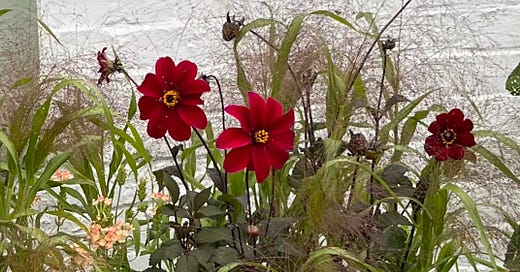Hello and welcome to any new subscribers this week, it’s lovely to have you here. You’ll find out more about me and about what happens week by week here. If you haven’t already, do download the Substack app (see link below), where you can make comments and start threads in Chat, or on Notes, which is Substack’s version of Twitter or Instagram. You’ll find all sorts of interesting journalism there on multiple topics. For those who just want to continue reading my newsletter in their email inbox - that’s absolutely fine too of course!
Back in April I posted my summer pot recipes containing a mix of annuals and perennials with some bulbs thrown in too. This week I’m offering an alternative with some less demanding plants. Like everyone else I’m feeling the pain of having to water my pots every day. Not only is it time-consuming, it feels wrong with the current environmental concerns to be using all that water. And growing plants in pots can be pretty labour-intensive - all that filling and emptying and replacing to achieve the best seasonal displays. But they don’t need to be hard work.
I interviewed an inspirational woman called Ozichi Brewster earlier this year who made me think twice about my pots. Brought up in a Nigerian village for the first eight years of her life, she is now the RHS’s first Therapeutic Gardener and runs a community garden at Bridgewater Garden near Salford. Her perspective on the pressure we put upon ourselves in our gardens was interesting: ‘The English garden is about perfection, and intensive gardening is exhausting,’ she said to me. ‘If you over-stress about your garden, it becomes demoralising.’
This made me think long and hard about what I try to do in my garden. I’m so busy juggling work and family during the week and then spend all weekend trying to achieve some sort of perfection in the garden. Mostly, my garden is quite forgiving - the borders are relaxed and naturalistic in style and can take a fair amount of neglect. Most of my pots, however, are like hungry babies needing constant feeding and watering. You turn your back for just a few days (or go away and leave boys in charge) and they swiftly go downhill.
I’d say about two thirds of my pot collection is reserved for annuals, all of which I sow from seed each year. I wouldn’t want to completely stop my seed-sowing regime in spring because I love doing this more than anything else in the garden - but perhaps next year I’ll try to be more discerning and more realistic about the amount I sow. There’s nothing more stressful than seeing an entire table full of seedlings bursting at the seams waiting to be planted out. So next year my goal is to switch this proportion around to a third annuals and two thirds lower maintenance perennials, shrubs and grasses for the pots. The planting ideas that follow include more drought-tolerant perennials that won’t keel over at the first hurdle. I’m not saying that these pots can be entirely ignored by the way - any plant in a pot needs more watering and feeding than it does when it’s in the ground - but these are plants that will hopefully still be growing strong when you get back from holiday rather than a mass of desiccated stems and foliage.
Keep reading with a 7-day free trial
Subscribe to Bud to Seed to keep reading this post and get 7 days of free access to the full post archives.






